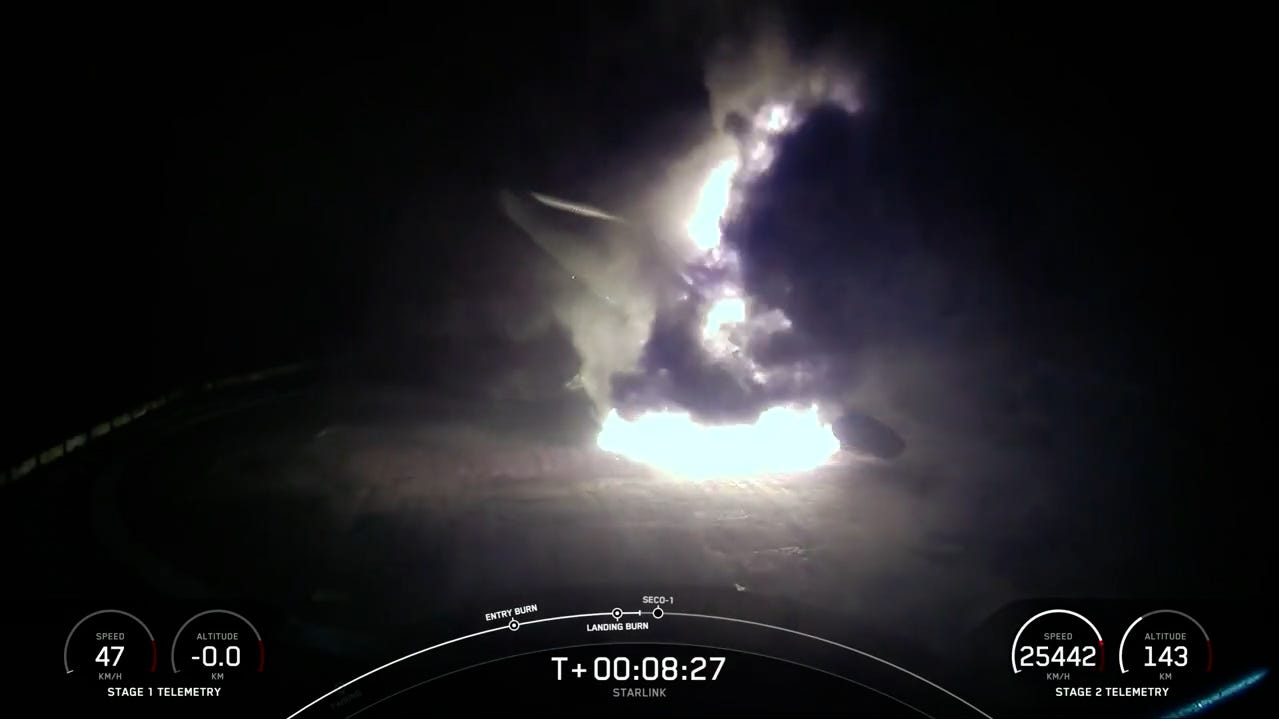The future of both Polaris Dawn and Crew-9 now appears uncertain after federal regulators halted Falcon 9 launches again to determine why the fiery landing occurred early Thursday.

Watch SpaceX’s Falcon 9 first-stage booster tilt after landing
The Falcon 9 first stage booster overturned and caught fire while attempting to land aboard a SpaceX drone in the Atlantic Ocean.
- The accident occurred early Thursday when a rocket booster from an unmanned SpaceX mission skidded and exploded as it returned to Earth.
- The failure occurred during the launch of SpaceX’s Starlink Internet satellites from the Cape Canaveral Space Force Station.
- The latest FAA grounding will complicate SpaceX’s plans to launch a Polaris Dawn crew aboard one of its SpaceX Dragon capsules, and could affect the Crew-9 launch if the investigation drags on.
Two important crew SpaceX missions could be at risk Federal regulators laid the groundwork The company’s Falcon 9 rockets will investigate the cause of the fiery landing accident following the successful launch of a Jupiter satellite.
SpaceX is looking for a possible window to launch four private astronauts into orbit on the Polaris Dawn mission, where the crew hopes to become the first commercial astronauts to conduct a spacewalk. The launch has already been delayed three times.
Next month, two NASA astronauts are scheduled to travel to the International Space Station aboard Crew-9, which will also bring home the Boeing Starliner test crew in February. Last week, NASA determined that Starliner was unsafe to return to Earth after astronauts Suni Williams and Butch Wilmore arrived at the orbital outpost in a Boeing capsule in June.
But the futures of both Polaris Dawn and Crew-9 now seem even more uncertain.
The Federal Aviation Administration has ordered that no launches involving Falcon 9 rockets take place until after a rocket booster, shortly after a SpaceX mission. It exploded early Wednesday morning On returning to earth.
Polaris Dawn: SpaceX delays Polaris Dawn again, this time due to ‘unfavorable weather’ for splashdown
Rocket booster lands after SpaceX satellite delivery
A rocket booster malfunctioned while launching SpaceX’s Starlink Internet satellites into orbit from the Cape Canaveral Space Force Station early Thursday morning.
Although the overall mission seemed successful, the Falcon 9 rocket’s first stage failed to land properly on board the unmanned drone, dubbed “A Shortfall of Gravitas.” Instead, the booster exploded and sent it flying Flames burn around the destroyed boosterIt then fell on its side.
No injuries or property damage were reported after the crash, which occurred during the booster’s 23rd flight.
However, the Federal Aviation Administration, which licenses commercial rocket launches, plans to halt any further Falcon 9 launches until the cause is determined.
The FAA said in a statement that Falcon 9 would be the foundation for “identifying appropriate actions to prevent that from happening again.”
“An investigation designed to further enhance public safety,” the statement said. “The FAA will be involved in every step of the investigation process and must approve SpaceX’s final report, including any corrective actions.”
The second is the FAA foundation
This is the second landing of a Falcon 9 rocket in as many months.
In July, FAA lands SpaceX’s Falcon 9 Rockets blocked a batch of satellites after an upper-stage liquid oxygen leak caused them to re-enter Earth’s atmosphere and burn up during the Starlink launch in California.
FAA officials gave SpaceX permission to resume launches Two weeks later.
What is the foundation for Polaris Dawn?
The recent FAA grounding will complicate SpaceX’s plans to launch a Polaris Dawn crew in one of its SpaceX Dragon capsules.
That commercial spaceflight — intended to send four more crews into space than humans have had in more than 50 years — has already faced three delays. Billionaire businessman Jared Isaacman He came with his crew A week before quarantine at the Kennedy Space Center in Florida.
The Polaris Dawn launch was most recently scheduled for a Wednesday morning liftoff before SpaceX scrubbed the mission at the last minute due to bad weather forecast for its return to Earth. The launch was delayed earlier to give more time for preflight checks, and when a helium leak – since fixed – was discovered.
Friday would have been the day before Polaris Dawn was launched, but the FAA grounding has now thrown the mission into disarray.
The ambitious space mission will attempt to take crews to higher altitudes than humans have traveled since NASA’s Apollo program in the 1970s. While in orbit, so will the Polaris Dawn crew First spacewalk by non-governmental astronauts Test SpaceX technology that could pave the way for future deep space exploration.
Polaris Dawn Book Reading: Polaris Dawn’s Anna Menon wrote a book for her children that she will read from orbit
Will the Crew-9 launch be delayed?
If the investigation drags on long enough, SpaceX will have to make a decision about launching its Crew-9 mission.
The two Crew-9 astronauts are scheduled to depart for the International Space Station on September 24, where they will remain in orbit for their usual six-month rotation.
However, the assignment has already been delayed once Time for NASA and Boeing to decide What about the Starliner spacecraft and the two-man crew that drove it to the orbital outpost? On Saturday, NASA Administrator Bill Nelson announced that the stranded Starliner would return to Earth without its astronauts Williams and Wilmore.
The Starliner crew instead plans to stay aboard the space station until February, when they hope to be able to fly home on the SpaceX Dragon following the completion of the Crew-9 mission.
Eric Lagatta covers breaking and trending news for USA TODAY. Reach him at [email protected]